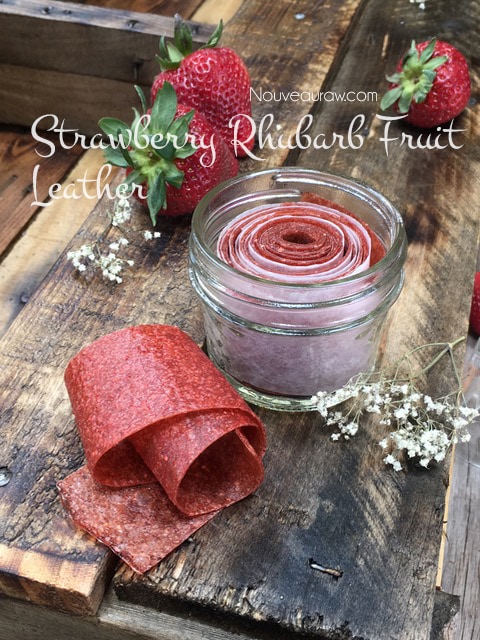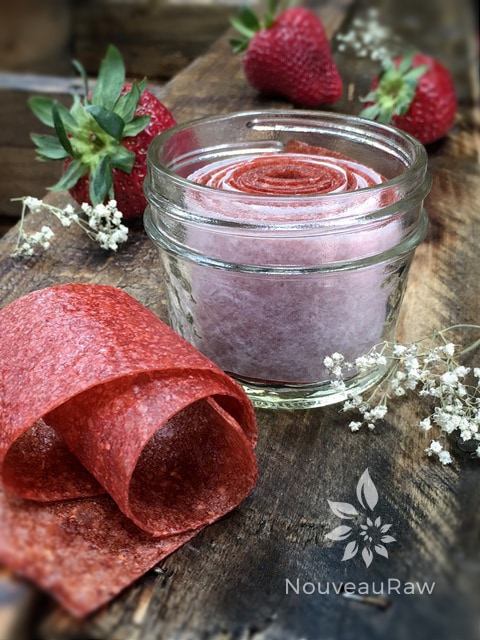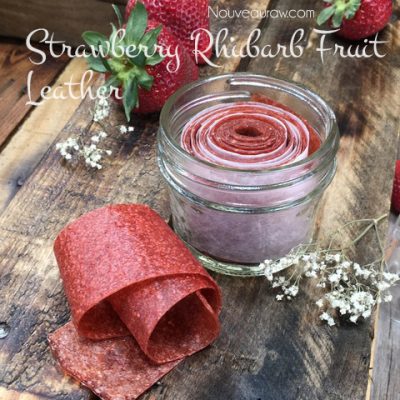Strawberry Rhubarb Fruit Leather

 Add to favorites
Add to favorites

~ raw, vegan, gluten-free, nut-free ~
Strawberry Rhubarb Fruit Leather is sweet and tart all rolled into one. (no pun intended)
The trick when using rhubarb in fruit leather is to cook it down. But since this is a raw site, I am going to provide you with a technique that helps to break the rhubarb down which will not only soften the fruit stalk itself, but soften the sour flavor.
I was so excited this year to plant 4 more plants (a sweet surprise from my husband). I am not new to eating rhubarb but I am now learning the ropes when it comes to growing and harvesting.
Green Thumb & Patience
But here’s the hard part for me… since my plants are new, it is suggested that I wait two years before taking a full rhubarb harvest from the plant. This is to ensure the plant is sufficiently established. So, not only do I need to polish my green thumb, now I need to add patience into the mix. Oy-vey… that’s asking a lot from me. hehe
When it comes to rhubarb, the stalks are the only things eaten. You will want to avoid eating the leaves because they are extremely high in oxalic acid, which can cause severe illness in people, resulting in the common belief that rhubarb is poisonous. I thought it was important to bring this up again (as I have in other rhubarb recipes) because we raw foodies love to juice green leaves. :)
Harvesting your selection at the super market.
If you are “harvesting” the rhubarb from the local produce department, there are a few key things to look for. For starters, you won’t find the leaves attached to the stalk due to the toxicity of them. Don’t get hung up on the color, that doesn’t necessarily indicate ripeness. They can be crimson, pink, or even a pale green. You want to select stalks that are at least 10″ in length, firm and without blemishes. If you see crimson colored stalks that have a lot of color rubbed off, this is an indicator that they have been handled and bounced around a lot.
After I made this fruit leather I had it sitting on the counter for days before I have a chance to do anything with it. As soon as I cut it into strips, rolled it up, and placed it in a the little jar… my husband ate the whole thing within a few minutes. Just goes to show you the power of presentation. hehe I hope that you enjoy this simple and summer filled recipe, Blessings, amie sue
 Ingredients:
Ingredients:
- 8 cups sliced rhubarb (roughly 13 stalks)
- 4 cups diced strawberries
- 1/2 cup maple syrup
Preparation:
- Wash and dry the rhubarb and strawberries.
- Slice the rhubarb into 1/4″ slices, discard the leaves (again, they are toxic).
- Place the rhubarb, strawberries and maple syrup in a ziplock bag, close and shake, coating all the pieces.
- Pour everything into a glass container that will fit inside of the dehydrator, cover with plastic wrap and slide the container into the bottom of the dehydrator. I use the Excalibur machine.
- Dehydrate at 115 degrees for 8 hours. The rhubarb will soften and create extra sauce.
- The color will fade, and the bitterness of the rhubarb will totally soften.
- You know it’s done when the rhubarb is totally soft, but you can stop the process at the flavor level that you like.
- Once it is done marinating, drain the liquid (save to add to smoothies, or create a dressing from it).
- Place the rhubarb and strawberries in the blender and puree until smooth.
Creating the fruit leather:
- Spread the fruit puree on teflex sheets that come with your dehydrator. Pour the puree to create an even depth of 1/8 to 1/4 inch thickness. If you don’t have teflex sheets for the trays, you can line your trays with plastic wrap or parchment paper. Do not use wax paper or aluminum foil.
- Lightly coat the food dehydrator plastic sheets or wrap with a cooking spray, I use coconut oil that comes in a spray.
- When spreading the puree on the liner, allow about an inch of space between the mixture and the outside edge. The fruit leather mixture will spread out as it dries, so it needs a little room to allow for this expansion.
- Be sure to spread the puree evenly on your drying tray. When spreading the puree mixture, try tilting and shaking the tray to help it distribute more evenly. Also, if you don’t have an Excalibur or similar dehydrator, it is a good idea to rotate your trays throughout the drying period. This will help assure that the leathers dry evenly.
- Dehydrate the fruit leather at 145 degrees (F) for 1 hour, reduce temp to 115 degrees (F) and continue drying for about 8 (+/-) hours. Flip the leather over about halfway through, remove the teflex sheet, and continue drying on the mesh sheet. The finished consistency should be pliable and easy to roll.
- Check for dark spots on top of the fruit leather. If dark spots can be seen it is a sign that it is not completely dry.
- Press down on the fruit leather with a finger. If no indentation is visible or if it is no longer tacky to the touch, the fruit leather is dry and can be removed from the dehydrator.
- Peel the leather from the dehydrator trays or parchment paper. If it peels away easily and holds its shape after peeling, it is dry. If it is still sticking or loses its shape after peeling, it needs further drying.
- Under-dried fruit leather will not keep; it will mold. Over-dried fruit leather will become hard and crack, although it will still be edible and will keep for a long time
- Storage: To store the finished fruit leather…
- Allow the leather to cool before wrapping up to avoid moisture from forming, thus giving it a breeding ground for molds.
- Roll them up and wrap them tightly with plastic wrap. Click (here) to see photos of how I wrap them.
- Place in an air-tight container, and store in a dry, dark place. (Light will cause the fruit leather to discolor.)
- The fruit leather will keep at room temperature for one month, or in a freezer for up to one year.
Culinary Explanations:
- Why do I start the dehydrator at 145 degrees (F)? Click (here) to learn the reason behind this.
- When working with fresh ingredients, it is important to taste test as you build a recipe. Learn why (here).
- Don’t own a dehydrator? Learn how to use your oven (here). I do however truly believe that it is a worthwhile investment. Click (here) to learn what I use.
© AmieSue.com
Tags: Dairy Free, Dehydrated, Gluten Free, Nut Free, Refined Sugar Free, Soy Free, Vegan



 Add to favorites
Add to favorites
 Ingredients:
Ingredients:
Finally, a use for my rhubarb, can’t wait to try it.
Awesome. :) I LOVE rhubarb. If you are looking for other delicious ways to use up some of your rhubarb, type “rhubarb” in the search box on the site and more recipes will appear. blessings, amie sue